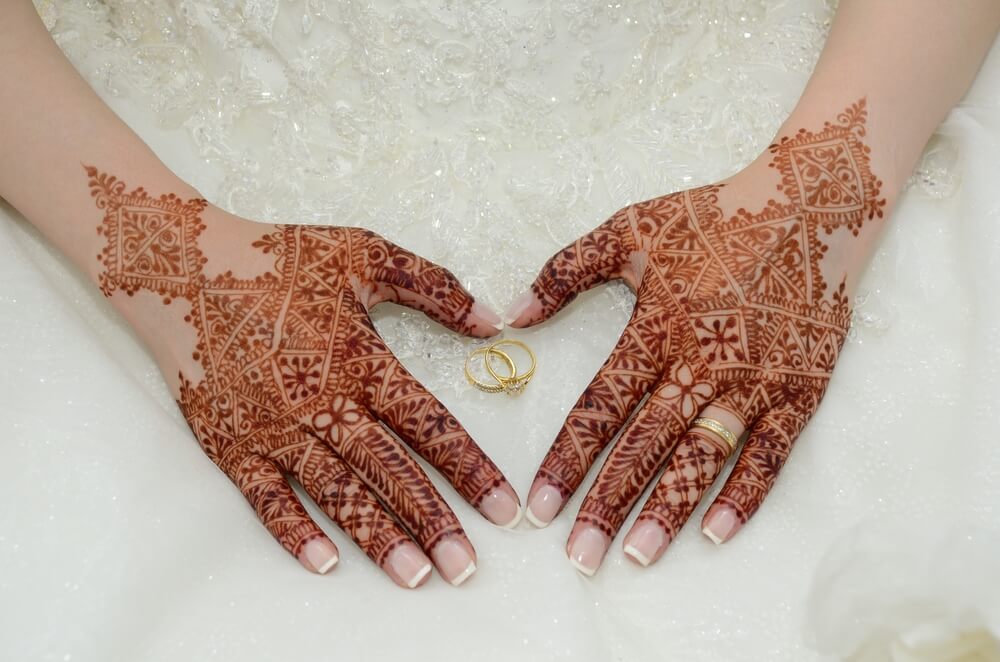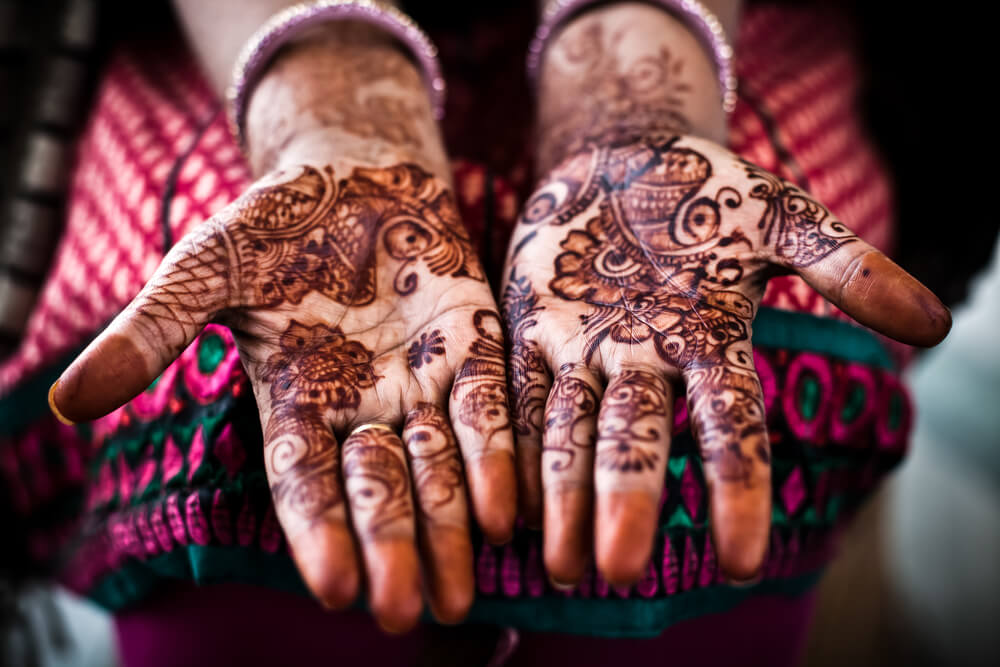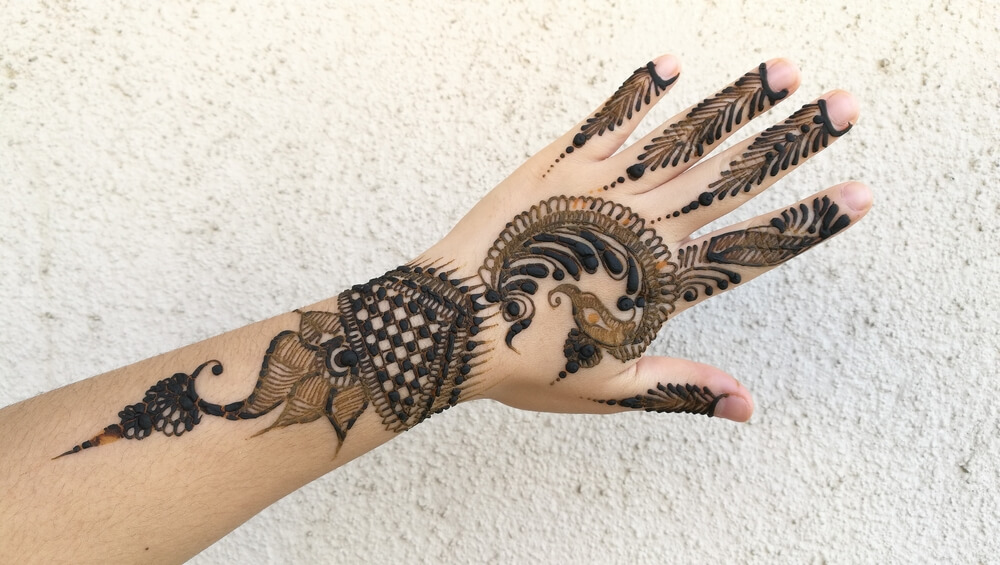Henna has been used as a herbal for centuries in the Middle East and Indian sub-continent countries. It is mentioned in the Quran as well as in other religious texts. Henna Painting in Dubai is a spiritual, cultural, and social activity. This is more popular with Women, who choose to put decorative tattoos of Henna during festivals like Eid and Deewali, marriages, engagements, as well as even going out with friends. On all essential and happy occasions, one would find a special henna tattoo corner where expert artisans apply on delicate hands. The tattoos turn into blackish red in no time. Henna painting in Dubai is also popular during desert safaris when the safari comes to the Arabian campsite for a BBQ dinner.
Cultural Significance of Henna in Dubai
The cultural significance of Henna in Dubai is not just limited to its decorative use. Henna is considered to be of very high medicinal value, a fact that adds to its allure. The Henna leaves, when crushed and made into a fine paste, serve a variety of purposes. This is the usual process followed in countries like India, Pakistan, Nepal, and all the GCC countries. Even during the days of the Pharaohs, the Egyptians used Henna on hair, face, and hands to prevent burns from the summer sun. It was a ‘sunscreen’ back in those days, a fascinating historical use that adds to the intrigue of this ancient art form. Men would color their hair with Henna, and women would use it as shampoo, even during the biblical era. In the Indian subcontinent, Henna was considered a harbinger of good luck, and women would apply it during important festivals and occasions on hair as shampoo and on palm and fingers as tattoos.

Traditional Henna Designs
Traditional Henna designs are a testament to the intricate beauty of this art form. They emphasize delicate leaves, veins, and flowers, creating a mesmerizing visual effect. The Arabic designs, with their bold flowing lines and paisley patterns, cover the entire palm, fingers, and may even extend up to the arms. The Indian subcontinent henna tattoos are equally captivating, with floral patterns and lines extending throughout the entire hand. Another distinct feature of Indian design is that even the tip of the fingers is covered with Henna, adding to the overall allure. The Moroccan henna tattoos, mostly geometric shapes, also hold a unique charm. In Dubai, Henna painting has evolved into an art form that combines various cultural and traditional patterns, each more beautiful than the last.
Modern Henna Trends
The Henna paintings have been changing just like other fashion stuff. The traditional designs have given way to bolder expressions. Even natural Henna has been given to a mix or completely artificial henna. The modern Henna trend is also applied to other parts of the body. This includes the legs and back. Henna is highly evolved in Dubai, and the design becomes increasingly elitist based on what you can pay. The trends are strongly linked to modern and Islamic art development, which is closer to abstract art.
Henna Artists and Studios in Dubai
There are hundreds of Henna tattoo studios in Dubai, where top Henna artists provide unique and costly services. One such studio is Luxury Henna Studio, Sheraton Hotel Jumeirah. An Emirati Lady runs this place; you will get henna from Sudan, India, and Morocco. Here, you get the best herbal Henna mixed with lemon, sugar, and tea tree oil. The expensive paste is then applied with the help of cones. Then you have such studios as SAbeauty Professional Lady Salon, Eyana Beauty Parlor, Karama, and Afrina Beauty Center, Al Mamzar. However, Heritage for Henna is the most well-known henna studio. They use a highly pure Henna mixed with lemon and essential tea tree oil. To get a very stable color, they also use sugar. All these are handmade into a fine paste. This paste is applied to the customer’s hands, palms, arms, and even the neck area using traditional means. They also organize special training camps for those who want to apply henna.

Henna Painting for Special Occasions
In Dubai, Henna paintings are for general and special occasions. Special occasions like marriages, Eid, Ramadan, and other local festivals mean women queuing for henna painting. The shopping malls and arcades offer free henna paintings to increase footfall. The stand-alone studios also offer special packages and promises. During local marriages, Henna paintings are a MUST. The bride’s family booked a henna artist way before. The Henna artist brings her kit and unique henna mix for a lasting tattoo effect. On special occasions like Iftars and Ramadan, the hospitality tents have free or paid henna painting provisions. During the marriages, as per the Islamic traditions, the women guests are welcomed with free henna tattooing. The Emirati custom involves henna painting for women during birthdays, engagements, and other social occasions.
Bridal Henna in Dubai
Bridal henna in Dubai is a huge deal. On a bride’s to-do list, henna occupies the top position. The bride and her friends start finalizing one of the more famous henna artists for this occasion. The henna artist is given time to submit designs, which are finalized per the bride’s choice. During the marriage, the henna artist spends hours painting the hands and arms of the bride while her assistants do the painting for her friends and female guests. Traditionally, only the bride’s hands can be seen; hence, hours are spent to make them look most beautiful. Usually, the lady chosen by the bride is married and old, believing that the new marriage will also be long-lasting and happy. The local belief is that the henna helps release hormones linked to fertility.
Henna Painting Techniques
Henna painting techniques are many. However, the most critical technique involves;
Preparing the henna paste involves mixing the raw henna leaves with essential tea tree oil, sugar, and lemon and converting the mix into a fine paste. This step looks very simple but detailed, as the ratio of each in the mix determines the final color and longevity. Expert henna artists vouch that preparing the right mix is the key to getting the best outcome.
Applying the Henna paste – In most cases, the henna paste is poured into a longish cone. The bottom of the cone is cut, making a small hole. The henna artists use the cone as a pen to draw intricate patterns. The cone’s tip must be constantly cleaned with a tissue so that the henna blob does not spoil the design. It is a very skillful art as the cone should not be pressed too hard, or too much henna will come out from the hole and spoil the intricate detail. The focus of the henna painter is of utmost importance. It is after a painting on a body surface, and any change in concentration will spoil the intricate details.
The next step is to leave the painted surface to dry. This is the step that ladies enjoy the most. They keep their hands and arms away from being touched. The bride will be fed by her mother or friends while she lets the henna dry slowly.
Washing the henna—Once the henna painting becomes fully dry and starts peeling off like a fine powder, the surface will be washed off. The quality of the henna will become clear if the painting becomes dark red, which then slowly matures into red. If quality henna is applied, there will not be any itching on the hands, and the henna will last for at least 2 to 3 days in its original color and then start fading off slowly.
Safety and Skin Care
Original henna is very safe as it has excellent medicinal properties. The Indian Ayurvedic medicine and Islamic Yunani medicine describe in detail the virtues of Henna in healing skin diseases. However, there are a lot of different henna brands in the market. Many use artificial dyes to get a more attractive finish and various shades. These artificial henna products may be harmful to the skin and may prove to be
DIY Henna Kits and Tutorials
In Dubai, there are readymade henna cones. This cone has detailed instructions on how to apply the henna. A good pair of hands can use this cone to make intricate designs. Some cone combo packs have beautiful design books for different occasions. The user must cut the tip, follow the instructions, refer to the design, and apply it herself. These henna cones are highly popular and become handy for working women who do not have time to visit a studio. For casual occasion, these DIY cones are

Where to Buy Henna Products in Dubai
Henna is practically available across all supermarkets. They keep the henna cones at the cashier so you can pick them up on the go. There are specialized beauty salons where custom-made henna paste is available. Many shops in Dubai now sell readymade design stencils and henna paste. One must pour the henna paste into the design stencil and put it on the arm, hand, and palm. We advise you to carefully read the ingredients on the cone and the artificial content. You must avoid Ammonia abased Henna at any cost.
We advise you to buy from a trusted source like a well-known supermarket and keep only approved products.
Henna Festivals and Events
Henna festivals and events are regular side activities. In festivals such as Eid, Deewali, and Karwa Chauth, henna takes center stage. Even during the Desert safari and some Dhow dinners, henna is an essential attraction as it is part of the package. Popular tourist spots have henna corners where visitors can get their hands tattooed with beautiful and elaborate tattoos by expert ladies who are well-trained in this art and have a good henna paste.
Henna in Dubai’s Tourist Attractions
Henna is a cultural icon in the Middle East. Hennai is significant in Dubai’s tourist attractions. Many tourists from the West, such as Europe, Russia, and the Americas, find it very attractive and spend a lot of time getting their hands tattooed and posting the pictures on Facebook and Instagram. The DTCM lists henna tattoo activity as one of the preferred activities of women tourists. It is a wholesome family fun thing suitable for women of all ages.
Visitor Experiences and Testimonials
Visitors are amazed at the type of design and intricacies available in Dubai for henna painting. Women also find it easy to buy henna cones from nearby supermarkets and apply it themselves from the design book that comes with it.
Conclusion
Henna Painting is part of Dubai’s folklore and Islamic culture. Due to its popularity, Dubai henna artists are always in big demand. They create fantastic henna designs. There are many excellent henna painting studios in Dubai. However, you may refer to the websites dedicated to henna designs and know the best places for henna painting in Dubai for your specific occasion. Traditional henna painting in Dubai is influenced by Indian, Emirati, Egyptian, and Moroccan factors.
FAQs:
How long does henna painting last?
If you have used the correct mix of henna, lemon, sugar, and essential oils, your henna will easily last 7 to 10 days.
Is henna painting safe for all skin types?
Yes, herbal henna that does not contain harmful chemicals is safe for all skin types.
Can I get the henna painting done at Dubai shopping malls?
Yes, most of the malls in Dubai provide free henna paintings for their visitors. Most of these designs are essential, and if one wants a more elaborate design, then you need to pay for that.

